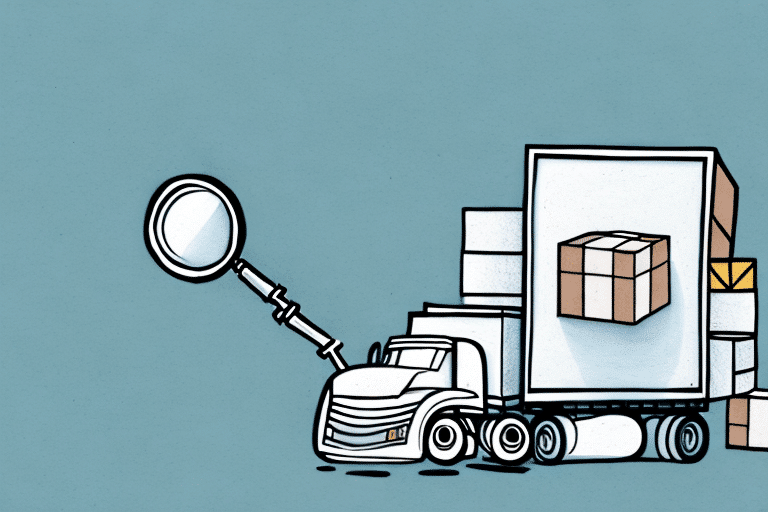4 Steps to Build the Business Case for Transportation Auditing
Transportation is a vital component of any business that involves moving goods from one location to another. However, transportation costs can be expensive, and businesses need to streamline their processes to ensure that they are not overspending while also maintaining reliable and efficient transportation services. One solution to this issue is transportation auditing, which allows a business to analyze its transportation processes and identify areas for improvement. In this article, we'll cover four essential steps to building the business case for transportation auditing, including understanding the benefits of transportation auditing, conducting a transportation audit, creating a plan for implementing transportation auditing processes, and presenting your business case to key stakeholders and decision-makers.
Understanding Transportation Auditing
Why Transportation Auditing is Important for Your Business
Transportation costs can account for up to 60% of a company's total logistics expenses. Without proper auditing, your business might be overspending in this area. According to a U.S. Department of Transportation report, effective transportation management can reduce costs by 15-20%. Transportation auditing allows businesses to identify inefficiencies and implement cost-saving measures, leading to enhanced efficiency, better customer service, and improved compliance with regulations. With the increasing demand for fast and reliable transportation services, transportation auditing ensures that your business stays competitive and delivers high-quality services to your customers.
The Benefits of Conducting Transportation Auditing
There are several benefits that come with conducting transportation auditing:
- Cost Reduction: Auditing helps identify cost-saving opportunities. For instance, route optimization can lead to fuel savings, potentially reducing transportation costs by up to 10%.
- Enhanced Efficiency: By identifying bottlenecks in transportation processes, businesses can streamline operations, reducing turnaround times and increasing productivity.
- Regulatory Compliance: Auditing ensures that transportation processes comply with all relevant regulations, avoiding costly fines and legal issues.
- Improved Customer Satisfaction: Efficient and reliable transportation services lead to faster delivery times and better service quality, enhancing customer satisfaction.
In summary, transportation auditing helps your business become more cost-efficient, reduces turnaround times, improves compliance, and enhances customer satisfaction.
Understanding the Basics of Transportation Auditing
Transportation auditing is the process of analyzing your transportation processes to identify areas needing improvement. This involves gathering data, analyzing it, and creating a plan for implementing changes. Auditing includes reviewing documentation such as invoices, bills of lading, trip reports, and fuel and mileage logs. The analysis can focus on the entire transportation process or specific aspects like carrier selection, route optimization, load consolidation, and freight classification. Once the analysis is complete, businesses can determine cost-saving and efficiency-enhancing activities and develop a plan to implement them.
Building the Business Case for Transportation Auditing
Step 1: Identifying Areas for Improvement in Your Transportation Processes
The first step in any transportation audit is to identify areas of your transportation system that require improvement. This involves analyzing various components such as freight carriers, transport routes, and fuel consumption. When reviewing carriers, assess their performance in relation to costs. Are they delivering goods efficiently and on time? Consider diversifying your carrier pool to leverage competitive rates and improve service quality.
For transport routes, evaluate delivery times and routes taken. Identify any bottlenecks that could be addressed to reduce waste and delays. Utilizing route optimization software can help in making the best use of resources, such as truck capacity.
Fuel consumption is another critical area. Ensure that you are using fuel-efficient vehicles and accurately tracking fuel usage. According to the U.S. Energy Information Administration, even a 1% improvement in fuel efficiency can lead to substantial cost savings annually.
Step 2: Gathering Data and Analyzing Your Current Transportation Costs
After identifying areas for improvement, gather and analyze data detailing your current transportation costs. This includes reviewing documentation like invoices and bills of lading, as well as data from Electronic Logging Devices (ELDs), GPS tracking, and other digital tracking tools. According to a study by the Federal Railroad Administration, businesses that utilize comprehensive data analysis can identify cost-saving opportunities that were previously unnoticed.
Being thorough during this stage is crucial. The more data you collect and analyze, the more accurate your understanding of transportation costs will be, providing better insights for making improvements.
Step 3: Creating a Plan for Implementing Transportation Auditing Processes
With data in hand and a clear understanding of the areas that require improvement, create a plan for implementing transportation auditing processes. This involves:
- Selecting Key Performance Indicators (KPIs): Determine which metrics will be tracked to measure success, such as cost per mile, delivery times, and fuel efficiency.
- Choosing the Right Technology: Implement software tools that facilitate tracking and analysis of transportation data. Options include Transportation Management Systems (TMS) like Oracle Transportation Management and route optimization tools.
- Assigning Responsibilities: Identify team members responsible for the auditing process and ensure they are adequately trained to use the new tools and follow the revised processes.
Develop a training program to ensure that your team understands how to utilize the new technology and adhere to the optimized transportation processes to achieve cost and efficiency improvements.
Step 4: Building a Strong Business Case for Transportation Auditing
After implementing your transportation auditing processes, build a strong business case to institutionalize these changes across the business. To effectively present your case:
- Highlight Benefits and Savings: Clearly outline the benefits and potential savings from the auditing process. For example, businesses have reported up to a 15% reduction in transportation costs post-audit (Society for Human Resource Management).
- Provide Data-Driven Evidence: Use data from your audits to back up your claims. Present charts and graphs that illustrate cost reductions and efficiency gains.
- Emphasize Impact on Customer Satisfaction and Competitiveness: Explain how improved transportation processes lead to faster deliveries and better service quality, enhancing your competitive position in the market.
By presenting a data-backed, clear, and concise business case, you can gain the support of key stakeholders and decision-makers.
Implementing and Maintaining Transportation Auditing Processes
How to Present Your Business Case to Key Stakeholders and Decision Makers
To formally present your business case, schedule a meeting with key decision-makers and stakeholders. During the presentation:
- Use Clear Visuals: Incorporate charts, graphs, and other visuals to illustrate your data and the projected impact of transportation auditing.
- Be Concise: Present information in a clear and direct manner, focusing on key points and data that support your case.
- Address Questions Promptly: Be prepared to answer any questions or concerns that stakeholders may have. Provide evidence-based responses to build trust and credibility.
- Seek Feedback: Encourage feedback and be open to suggestions. This fosters a collaborative environment and may help address any reservations stakeholders might have.
Ensuring that all stakeholders are aligned and supportive is crucial for the successful implementation of transportation auditing processes.
Overcoming Common Objections to Implementing Transportation Auditing Processes
When presenting your business case, you may encounter objections such as concerns about costs, the time required to implement new processes, or potential disruptions. To overcome these objections:
- Demonstrate ROI: Present a clear Return on Investment (ROI) analysis showing how the cost of implementing auditing processes will be offset by the savings and efficiencies gained. Studies have shown that transportation audits can deliver an ROI of up to 200% within the first year (Harvard Business Review).
- Provide Benchmark Data: Use industry benchmarks to show how similar businesses have benefited from transportation auditing. This adds credibility to your proposal.
- Minimize Perceived Disruptions: Outline a phased implementation plan that reduces disruptions and allows for gradual adaptation to new processes.
By addressing concerns with data and a well-thought-out plan, you can effectively mitigate objections and gain stakeholder support.
Best Practices for Maintaining Effective Transportation Auditing Processes
After implementation, maintaining effective transportation auditing processes is essential for sustained benefits. Best practices include:
- Define and Track KPIs: Continuously monitor key performance indicators to assess the effectiveness of your transportation processes.
- Update Technology: Keep your auditing software and tools up to date to leverage the latest features and improvements.
- Regular Reviews: Schedule periodic reviews of transportation processes to identify new areas for improvement.
- Open Communication: Maintain transparent communication with all stakeholders to ensure ongoing support and collaboration.
- Training Programs: Regularly train staff on new processes and technologies to ensure proficiency and compliance.
- Conduct Ongoing Audits: Implement a schedule for regular audits to continually identify and address inefficiencies.
By adhering to these best practices, your transportation auditing processes will remain effective and continue to provide value and savings to your business.
Maximizing the ROI of Your Transportation Auditing Efforts
To maximize the Return on Investment (ROI) of your transportation auditing efforts:
- Conduct Regular Audits: Periodic audits help in identifying new cost-saving opportunities and addressing emerging inefficiencies.
- Share Success Stories: Regularly communicate the savings and improvements achieved through transportation auditing to stakeholders, reinforcing the value of the process.
- Seek Continuous Improvement: Always look for new ways to cut costs, improve efficiencies, and enhance customer satisfaction. Implementing innovative solutions like supply chain digitalization can provide additional benefits.
By following these strategies, you can ensure that your transportation auditing efforts continue to deliver significant ROI and contribute to your business's competitive advantage.
Finding the Right Partner to Help You Build Your Business Case and Implement Transportation Auditing Processes
Choosing the right partner is critical to the success of your transportation auditing processes. A reliable partner can provide expertise, technology solutions, and resources to maximize your investment. When selecting a partner, consider the following:
- Industry Experience: Look for partners with proven experience in your industry, as they will understand specific challenges and requirements.
- Comprehensive Solutions: Ensure that the partner can offer end-to-end solutions, from conducting audits to implementing new processes and training staff.
- Proven Track Record: Evaluate the partner's history of success with other businesses. Client testimonials and case studies can provide valuable insights.
- Technological Capabilities: The partner should offer advanced technological tools that facilitate efficient data collection, analysis, and reporting.
Partnering with the right organization can greatly enhance the effectiveness of your transportation auditing efforts and ensure successful implementation.
Future and Case Studies in Transportation Auditing
The Future of Transportation Auditing and What it Means for Your Business
The future of transportation auditing is increasingly intertwined with advancements in technology. Innovations such as data analytics, artificial intelligence (AI), and the Internet of Things (IoT) are transforming the landscape of transportation management. According to a report by McKinsey & Company, AI and machine learning can enhance route optimization, predictive maintenance, and demand forecasting, leading to significant cost reductions and efficiency improvements.
For your business, embracing these technologies means being able to leverage real-time data for more informed decision-making, improving the accuracy of audits, and identifying opportunities that were previously inaccessible. Staying up to date with these trends will help your business remain competitive and responsive to changing market demands.
Strategic partnerships with technology providers and continuous engagement with stakeholders will be essential in adapting to these advancements and fully realizing their benefits in your transportation auditing processes.
Real-World Examples of Successful Transportation Auditing Implementations
Numerous businesses have successfully implemented transportation auditing with impressive results:
- Large Shipping Company: By identifying the need to reduce fuel consumption, this company conducted an audit and implemented new transport strategies and technology, resulting in a 20% reduction in fuel usage and saving thousands of dollars annually.
- Consumer Goods Company: Through transportation auditing, this company identified inefficiencies in their supply chain. By consolidating shipments and streamlining routes, they reduced transportation costs by 15%.
- Retail Chain: A national retail chain utilized transportation auditing to optimize their delivery schedules and carrier selection, leading to a 10% increase in delivery speed and a 12% decrease in transportation expenses.
These success stories demonstrate that implementing transportation auditing processes can deliver significant value and improvements to businesses of all sizes and types.
Conclusion
Transportation auditing is a valuable process that helps identify inefficiencies and additional costs in your transportation system, enabling your business to achieve significant savings and improved customer satisfaction. By following the four essential steps to building the business case for transportation auditing and adhering to best practices, your business can meet its transportation goals and stand out in the industry. Embracing technology and partnering with experienced professionals will further enhance the effectiveness of your transportation auditing efforts, ensuring long-term success and competitiveness.






















